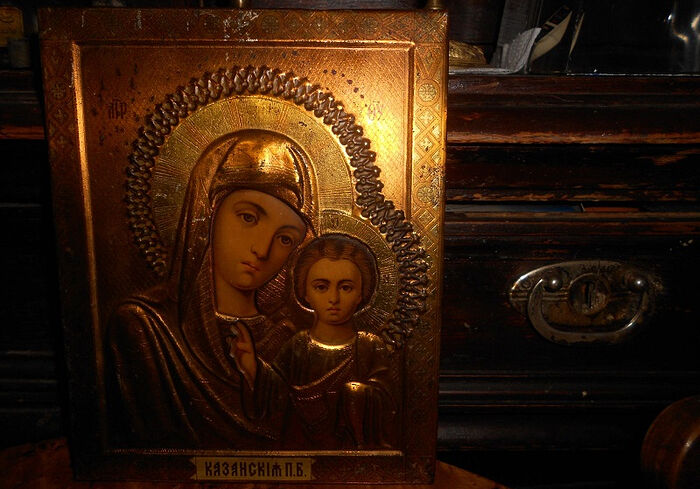My grandmother gave me a small icon of the Most Holy Theotokos for graduation. She said that this old icon had saved her loved ones many times: For example, my mother, when she was very sick with the measles in childhood; or my grandfather, when they tried to put him in jail on false charges of grand larceny (he was the director of a restaurant).
Seventh Sunday after Pentecost
SUNDAY, JULY 26, 2020
SYNAXIS OF THE HOLY ARCHANGEL GABRIEL;
THE HOLY FATHERS OF THE FIRST SIX ECUMENICAL COUNCILS
RESURRECTIONAL TROPARION - TONE SIX:
The angelic powers were at Thy tomb; the guards became as dead men. Mary stood by Thy grave, seeking Thy most pure Body. Thou didst capture hell, not being tempted by it. Thou didst come to the Virgin, granting life. O Lord who arose from the dead, glory to Thee.
The Holy Great-martyr Dominica (Cyriaca, or Nedelja) of Nicomedia (289)
During the time of the Emperors Diocletian and his son-in-law Max- imian, both adversaries of Christ, there lived in Anatolia two pious and elderly souls, Dorotheus and Eusebia. They were devout Christians, wealthy but childless.
St. Sava Trlajic
Sava Trlajić (19 July 1884 – August 1941) was a Bishop of the Serbian Orthodox Church serving as Bishop of the Diocese of Gornji Karlovac in the Kingdom of Yugoslavia from 1938 until the beginning of World War II.
He was killed by Ustaše of the Nazi Germany-aligned Independent State of Croatia in August 1941. The Serbian Orthodox Church venerates him as a Saint.
He was born Svetozar Trlajić to Stevan and Jelisaveta (née Karakašević) in Mol on 18 July 1884. His education included the primary school in his hometown, a grammar school in Novi Sad, and seminary in Sremski Karlovci. He then went on to graduate from the Faculty of Law at the University of Belgrade and passed the qualifying examination for judges at the Faculty of Law at the University of Zagreb.
In 1909, he was ordained a deacon by the Bishop of Timișoara and then presbyter ten days later. As a parish priest, he served at parishes in Peška and Bašaid. Early in 1927, he was appointed to an administrative position, and later general secretary, of the Holy Synod of Bishops of the Church of Serbia. When his wife died, he took monastic vows on 27 October 1929 in the Krušedol Monastery, being tonsured with the name Sava. Soon afterward he became abbot and archimandrite of the Krušedol Monastery. On 30 September 1930, Sava was elected Auxiliary Bishop of Sremski Karlovci. He was consecrated in Sremski Karlovci by Patriarch Varnava, Bishop Emilijan of Timok, Bishop Jovan of Niš, Bishop Tihon of the Diocese of Zahumlje and Herzegovina, and Bishop Simeon of Zletovo and Strumica. As Patriarchal Vicar Bishop Sava chaired the diocesan council of the Archdiocese of Belgrade and Karlovci. Fromearly 1937, Bishop Sava chaired the ecclesiastical court. He was appointed Bishop of Gornji Karlovac on 22 June 1938, with his residence in Plaški. After the death of Bishop Miron of Pakrac in 1941, he was also named administrator of the Diocese of Slavonia.
After the Invasion of Yugoslavia and the formation of the Nazi Germany-aligned Independent State of Croatia, Plaški was first occupied by Italian forces and then turned over to the Ustashi Croatians in late 1941. Bishop Sava and nine priests were then taken hostage. On 23 May 1941, Ustashi occupied the bishop's residence and expelled Bishop Sava. On June 8, the notorious executioner Josip Tomljenović ordered all diocesan money and records to be handed over to the Ustashi. Bp. Sava refused the Ustashi order to leave his diocese and go to Belgrade. Not wanting to abandon his flock, he refused. Bishop Sava was arrested on June 17, 1941, and confined, together with three other Serbian priests and thirteen eminent Serbian laymen, in a stable owned by Josip Tomljenović in Plaški. After experiencing intense torture, Bishop Sava and the priests, Bogoljub Gaković, Đuro Stojanović, and Stanislav Nasadilo, were chained and taken to the Gospić concentration camp on 19 July 1941. There, they were tortured until mid-August. At that time Bishop Sava was taken together with 2,000 Serbs toward the Velebit Mountains. Somewhere on this mountain, he suffered a martyr’s death together with thousands of other Orthodox Serbs. The site where Bishop Sava died is still unknown.
In 1998, at the regular session of the Holy Assembly of Bishops of the Serbian Orthodox Church, Bishop Sava was glorified and entered into the list of names of the saints of the Serbian Orthodox Church as hieromartyr.
His memory is celebrated on the 4/17 of July.
The Song of the Hagia Sophia
God sounds out, the earth sounds out, the heavens sound out.
And the Hagia Sophia also sounds out, the great monastery,
With four hundred sounding-boards and sixty-two bells,
For each bell a priest, for each priest a deacon.
Sound for the Holies to come out, for the emperor to come out.
A voice came to them from heaven and from the mouth of an angel:
“Stop the Cherubic hymn and lower the Holy gifts,
Because it is God’s will that the City become Turkish.
Only send a word to France [the West] for three ships to come,
One to take the Cross, another the Gospel,
And the third one, the best one, our Holy Table.
Don’t let the dogs take them and defile them.”
Our Lady is shaken and weeps and cries.
“Be quiet, our Maiden Lady, don’t cry, don’t weep.
Again, in years and in time, again it will be yours.”
(The lament of the Hellenic people, which is full of hope, after the Fall of Constantinople 1453)


